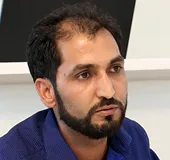Introduction
The modern India-Azerbaijan relationship is built on cultural and economic ties that materialised via the ancient Silk Route. Evidence of this history is seen at the Ateshgah fire temple near Baku, an 18th-century monument with wall inscriptions in Devanagari and Gurmukhi,[1] and the 14th-century Multani Caravanserai in the town of Icherisheher in the oldest inhabited part of Baku.[2] However, rivalry between Britain and the Soviet Union in the early twentieth century (while India was still under British rule and Azerbaijan was a Soviet state) weakened relations between India and Azerbaijan. Following the breakup of the Soviet Union, India established ties with the newly independent countries in the Caucasus region through diplomatic efforts. India was among the first countries to recognise Azerbaijan after its independence in December 1991, establishing diplomatic ties in February 1992.[3] In June 1998, the two countries signed an agreement on economic and technical cooperation, and in April 2007, they signed a deal to establish the India-Azerbaijan Intergovernmental Commission on Trade, Economic, Scientific and Technological Cooperation. This allowed India to establish a stronger and more meaningful relationship with Azerbaijan, creating new opportunities for cooperation and mutual benefit.[4] However, in recent decades, China's influence in Eurasia and hostility between India and Pakistan have impeded India’s attempts to establish direct connectivity for strong trade and economic relations with the region.
Consequently, India has pursued certain connectivity projects to overcome the impediments to direct connectivity and revive its age-old relationship with the Caucasus region. In 2002, India, Russia, and Iran signed an intergovernmental agreement to construct the 7,200-km long International North-South Transport Corridor (INSTC).[5] The INSTC is a multimodal transport route that includes sea, railways, and road links to connect Mumbai (India) to Saint Petersburg (Russia) via Iran. India also invested heavily in the Chabahar Port in the Iranian province of Sistan-Balochistan.[6] However, these initiatives faced delays due to investment challenges after renewed US sanctions on Iran,[7] inter-regional disputes, and bureaucratic hurdles for certain projects (such as the 628 km-long Chabahar-Zahedan railway line[8] and 164 km Rasth-Astara railway line). Still, in July 2022, the INSTC recorded its first shipment from Russia's Astrakhan Port to India’s Jawaharlal Nehru Port.[9]
Azerbaijan became part of INSTC in 2005, and its well-developed railways and a strategic seaport in Baku paved the way for the Western Route of INSTC that runs west of the Caspian Sea. The Western Route links the Iranian ports of Chabahar and Bandar Abbas in the Arabian Sea to the vast railway networks in Eurasia, especially with the Baku-Tbilisi-Batumi or the Baku-Tbilisi-Kars transnational rail connections constructed under Trans-Caspian International Transport Route (TITR, sometimes also called the ‘Middle Corridor’).[10] The TITR is also a multimodal route that enhances connectivity between Asia and Europe and spans Central Asia, the Caspian Sea, and the South Caucasus. This makes the Western Corridor of INSTC via Azerbaijan more economical and strategic for India. Additionally, the impacts of the Russia-Ukraine war, the COVID-19 pandemic, and the 2021 Suez Canal blockade have highlighted the need for new transport corridors and connectivity projects between the whole of Eurasia (encompassing all of Europe and Asia, a whopping 54.76 million square kilometres and home to about 60 percent of the world's population). At the same time, India’s robust economy needs connectivity to the vast Eurasian markets for reliable, resilient, and diversified supply chains.[11] Improving connectivity between India and the larger Eurasia region is crucial for fostering regional stability and facilitating economic growth for the countries involved.
This brief explores how the INSTC’s Western Route and TITR will enhance the India-Azerbaijan economic relationship and give New Delhi the opportunity for more reliable connectivity to Eurasia and Europe.
Azerbaijan’s Advantage: At the Crossroads of Connectivity
Located at the intersection between the East and West, Azerbaijan is gaining importance as a critical transit country along the Western Route of the INSTC. Azerbaijan has also invested heavily in upgrading its transportation infrastructure, especially its railways. Its railway infrastructure includes 4,286 km of rail track, 60 percent of which is electrified and 38 percent double-track,[12] showcasing the country's commitment to enhancing its transportation capabilities.[13] Between 2001 and 2016, Baku invested US$1.2 billion[14] towards modernising the rail network along the INSTC and TITR to ensure it is well-positioned to serve as a hub for north-south and east-west trade (see Map 1).
Map 1: The Western Route of the International North-South Transport Corridor and the Trans-Caspian International Transport Route
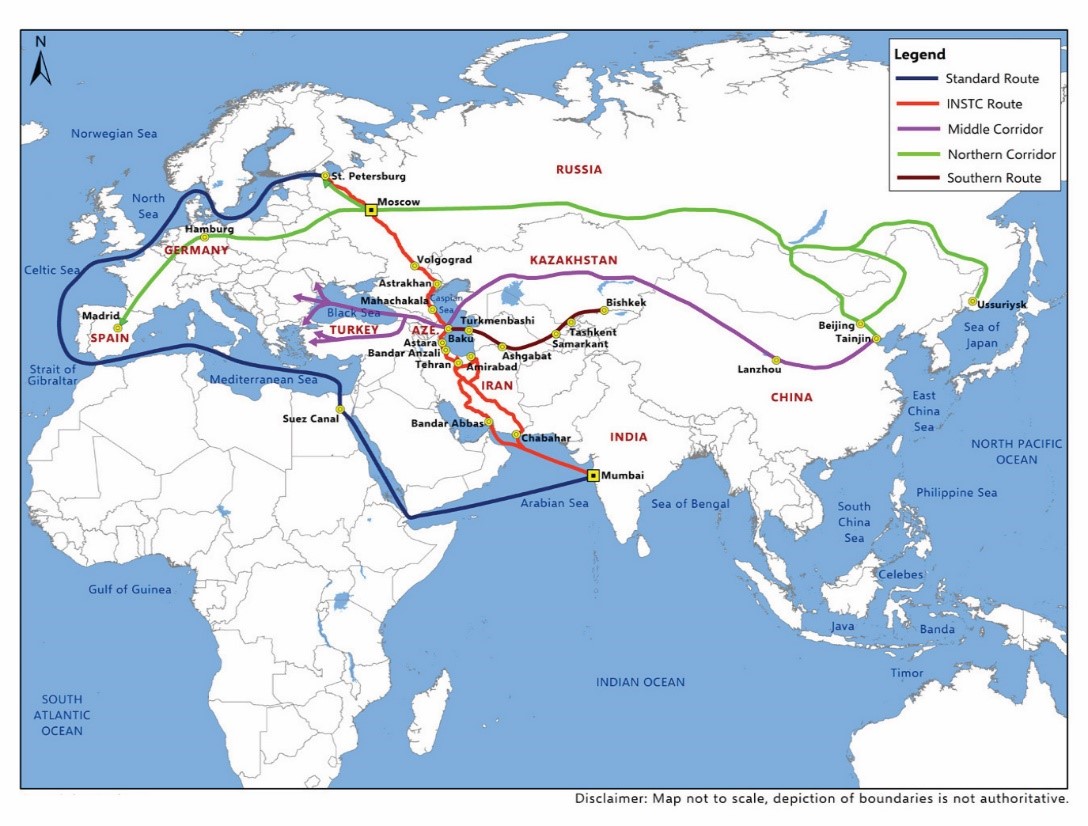
Source: Author’s own
INSTC’s Western Route
The INSTC, initially proposed in September 2000 by Iran, Russia, and India,[15] has now been ratified by 13 countries.[a] The INSTC includes sea routes and rail and road links, connecting India to the whole of Eurasia (see Map 2). The Eastern Route of the INSTC, also known as the KTI corridor, connects Russia and India and runs through Iran, Turkmenistan, and Kazakhstan, stretching about 6,100 km from the Russian-Finnish border to the Iranian port of Bandar Abbas.[16] The route also connects Uzen in Kazakhstan with Gyzylgaya, Bereket, and Etrek in Turkmenistan, and ends at Gorgan in the Iranian province of Golestan, giving the Central Asian Republics (CARs) access to the Arabian Sea and Indian ports. Construction of the Eastern Route began in 2009 following a trilateral agreement in 2007, with the Islamic Development Bank contributing US$370 million of the total cost of around US$1.4 billion.
Map 2: The International North-South Transport Corridor
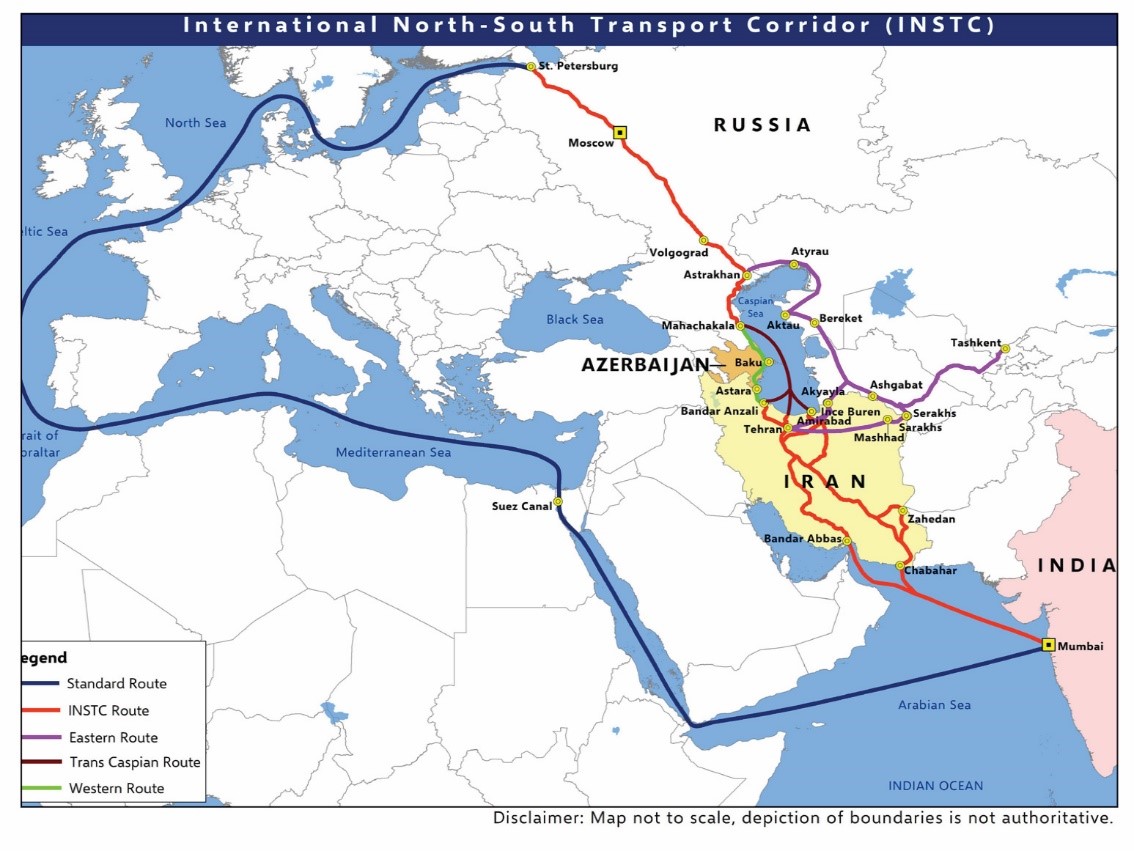
Source: Author’s own
The INSTC’s Western Route connects India’s Jawaharlal Nehru Port to Iran and Azerbaijan, spanning the western coast of the Caspian Sea and covering a distance of approximately 5,100 km from the Russian-Finnish border to the port of Bandar Abbas in Iran.[17] The Western Route is not only the shortest but also connects the most populous provinces of Russia and Iran.[18] The project gained traction in 2016 when Azerbaijan agreed with Russia and Iran to construct a railway line between the three nations.[19] In 2017, they decided to lower tariffs to promote cross-border trade via the INSTC. In the same year, the Asian Development Bank granted a US$400 million loan to modernise Azerbaijan's railway infrastructure, US$250 million of which was spent on repairing the 166-km double-line main track that connects the country to Russia and Iran.[20] Additionally, in 2022, Azerbaijan received US$9.3 million in technical support from the Asian Development Bank to improve its sustainable transportation, specifically railways.[21]
Azerbaijan also invested US$10 million in building a 10-km cross-border railway line between Astara (Iran) and Astara (Azerbaijan). Azerbaijan's national railroad operator also signed a 25-year agreement with Iran to operate a 35-hectare freight transhipment facility within the Iranian border. In March 2019, Iran completed and inaugurated the Qazvin-Rasht railway line, spanning 175 km along the Western Route. Despite the COVID-19 pandemic, cargo transit between Iran and Azerbaijan increased to 480,000 tonnes in 2020, with bilateral trade amounting to US$339 million.[22] In January 2021, the two countries signed a railroad cooperation agreement to increase cargo volume to two million tonnes annually. The volume of rail transportation along the INSTC increased by over 40 percent in the first five months of 2023 compared to the same period in 2022. Even though certain projects are still incomplete or under construction, most of the volume was transported through the Western Route (see Table 1)[23]
Table 1: Status of projects on the Western Route of the International North-South Transport Corridor
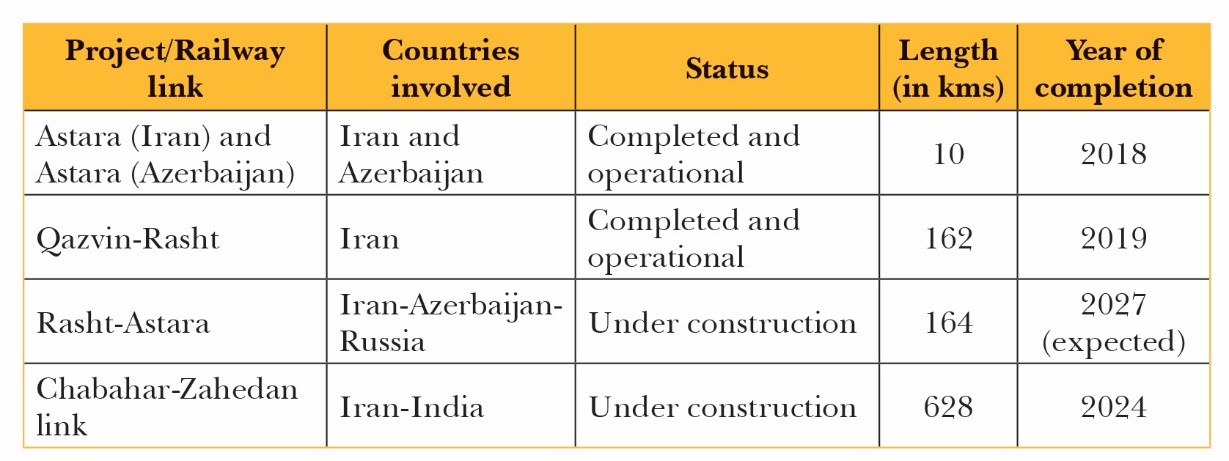
Source: Compiled by author from different sources
The 164-km stretch of the Rasht-Astara railway line between Iran and Azerbaijan has encountered construction delays, interregional divergences, and US sanctions on Iran.[24] The project was initially planned to be jointly funded by Iran and Azerbaijan in 2016, but US sanctions halted the agreement.[25] In May 2023, Russia and Iran inked a deal to complete the Iranian section of the Rasht-Astara railway line. This rail route has become crucial for Russia as Western sanctions due to its war in Ukraine have disrupted its Northern trade routes. Following a US$1.4 billion interstate loan from Russia, the Rasth-Astara railway has gained momentum.[26] Russia will have an 85 percent share of the loan amount, with cargo transit time between Saint Petersburg and Mumbai set to be reduced to 10 days from the current 25-30 days. The Rasth-Astara railway link is expected to be completed in 2027, with 15 million tonnes of cargo to be moved via this route.[27]
Additionally, to connect the strategic Chabahar Port with the Iranian railway system and INSTC, New Delhi and Tehran signed a pact in 2016 to build the 628-km Chabahar-Zahedan railway line. Disagreements over issues such as Iran’s desire to involve Khatam al-Anbiya Construction Headquarters, a company controlled by the Islamic Revolutionary Guard Corps (IRGC), in the construction halted the project. India could not work with the IRGC or any of its subsidiaries due to US sanctions.[28] After repeated funding delays by India, Iran agreed to drop the company from the project. Iran has proceeded with the track-laying process, and the railway line is now nearly halfway finished.[29] Completing the Rasht-Astara and Chabahar-Zahedan lines will improve the connectivity between Iran and Azerbaijan, with India able to reach any part of Eurasia via the Western Route more easily.
The Trans-Caspian International Transport Route
The Trans-Caspian International Transport Route (TITR), initiated in 2014, is a transport route that combines different types of infrastructure projects to improve connectivity and trade between Asia and Europe. The TITR passes through Central Asia, the Caspian Sea, and the South Caucasus and is the fastest and shortest reliable route between Europe and Central Asia. Comprising over 4,250 km of rail lines and 500 km of seaway, the TITR is 2,000 km shorter than Russia's Northern Corridor,[30] making it an ideal solution to sanction-compliance issues as it is more economical.[31]
In September 2017, the fully modernised Baku–Tbilisi–Kars railway between Türkiye and Azerbaijan via Georgia opened.[32] The Baku–Tbilisi–Kars railway is another vital artery of the TITR, connecting the Caspian Sea and the Black Sea. The line has been operational since 1983 and delivers oil and goods from Kazakhstan and Turkmenistan to Europe. The TITR also provides access to new markets and creates new business opportunities. Between 2014 and 2021, 49,000 cargo trains transited along the TITR, with an annual increase of 92.7 percent. In 2021 alone, 15,183 container trains transported 1.464 million[b] twenty-foot equivalent units (TEUs) of cargo, a substantial increase of 22.4 percent and 29 percent, respectively, along the TITR.[33] In 2022, container traffic along the route increased by 33 percent, and cargo traffic reached 1.5 million tonnes with 33,000 TEUs.[34] In the first nine months of 2023, 2 million tonnes of cargo were transported along the route, and the total capacity increased to 80,000 TEU containers. The TTIR currently has 25 transport and logistics companies from 11 member countries working on vessels and at ports, railways, and terminals.[c],[35]
In March 2022, Georgia, Azerbaijan, Türkiye, and Kazakhstan issued a statement emphasising the importance of advancing the TITR as an alternative route between Central Asia and Europe for trade and connectivity.[36] According to a roadmap agreement signed in 2022, the TITR countries are seeking to increase their capacity to 10 million tonnes per year by 2025;[37] notably, the corridor can triple trade volumes by 2030 if suitable investments and policies are implemented.[38] Towards this goal, in 2023, Azerbaijan, Kazakhstan, and Georgia also announced the formation of a joint railway venture for the smooth movement of cargo and to update their railway infrastructure. Additionally, the TITR countries are looking to create a single window system[d] along this route for the smooth and timely transition of the cargo.[39]
Table 2: Status of major Trans-Caspian International Transport Route projects and routes
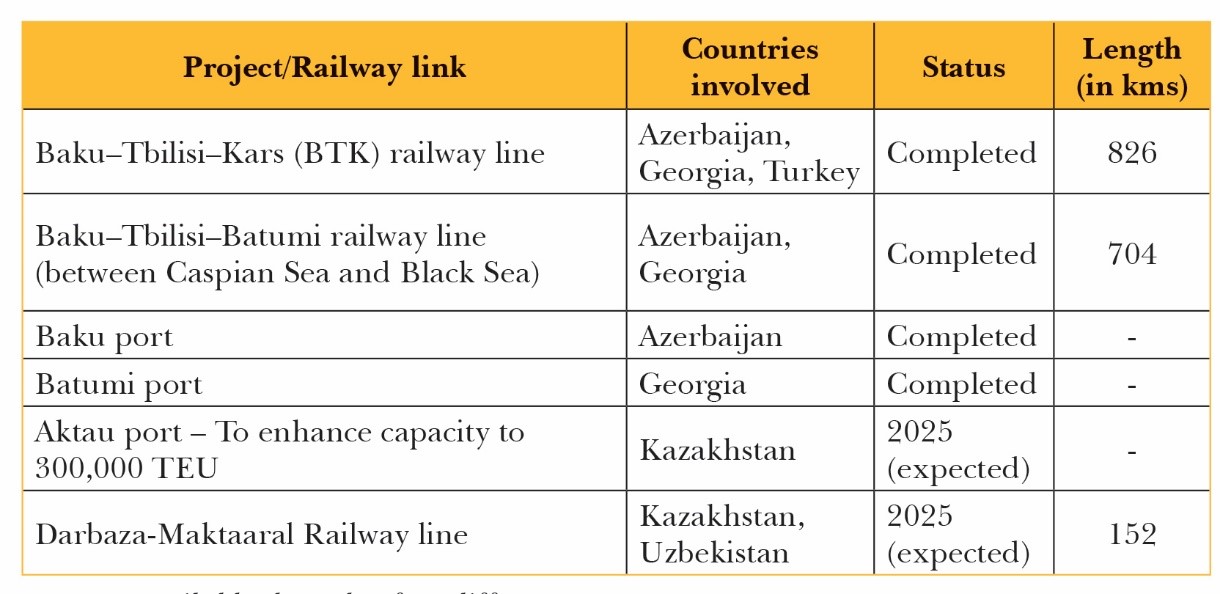
Source: Compiled by the author from different sources
Amid rising global interest in cargo transportation via the Caspian Sea, Azerbaijan has facilitated commerce between Europe and Asia through the Baku International Sea Trading Port. The Baku port contains two berths with 11 railway tracks connected to the national railway lines and highways and saw an annual turnover of 6.2 million tonnes in 2022.[e] Azerbaijan has also created a free economic zone at the port with provisions for dispute mitigations under international laws. Additionally, the country has the largest civilian fleet in the Caspian Sea with 52 cargo ships, and the Baku Shipyard can manufacture all types of vessels.[40]
The port's proximity to significant markets such as the CARs, Türkiye, Iran, India, and Russia enhances its potential as a hub for trade and commerce. This factors into Azerbaijan's larger plan to strengthen its non-oil economy and diversify away from hydrocarbons. The Baku port handles 17 million tonnes of dry cargo and 150,000 TEUs annually. It is being expanded to include two more loading berths, which will allow for handling 25 million tonnes of freight and 1 million TEUs. The port is designed for vessels with a deadweight of up to 13,500 tonnes, which is optimal for the Caspian Sea.[41]
Importantly, Azerbaijan has become Europe's key supply chain hub amid the Russia-Ukraine war.[42] Goods can be transported through ships from ports in Bulgaria and Romania to Georgia and Türkiye, where they are loaded onto trains and transported to the Baku port. From there, the goods can be shipped to China via Kazakhstan's Aqtau Port, to Central Asia via Turkmenistan’s Turkmenbashi Port, or to West Asia, India, and South Asia via the INSTC route from Iran's Anzali Port, which then leads to Bandar Abbas Port on the Persian Gulf. Additionally, the TITR provides Europe with an alternative transportation route for energy resources from Central Asia, especially since the traditional routes through Russia or West Asia are vulnerable to geopolitical tensions and disruptions.
The US has also pushed for “continued investment in and development of” the TITR and has pledged to use the G7 Partnership for Global Infrastructure and Investment to further critical transport, clean energy, critical minerals supply chains, and digital connectivity.[43] A stable and prosperous TITR could help the US and Europe mitigate, to some extent, the global competition with China, Iran, and Russia. China’s efforts to develop a freight corridor in the Caucasus region as part of the Belt and Road Initiative (BRI) have seen little results. Although China and Türkiye attempted to synergise the BRI and TITR, Beijing invested little in developing this corridor.[44] Additionally, some TITR countries expressed reservations about joint projects with China, citing the limited success of the China-Pakistan Economic Corridor and expressing uncertainty about Beijing's intentions.[45]
India and Azerbaijan: Opportunities and Challenges
Trade between Azerbaijan and India has increased substantially in recent years, from US$50 million in 2005 to US$1.882 billion in 2022 (see Table 3).
Table 3: India-Azerbaijan Trade, 2015-2022 (in US$ million)
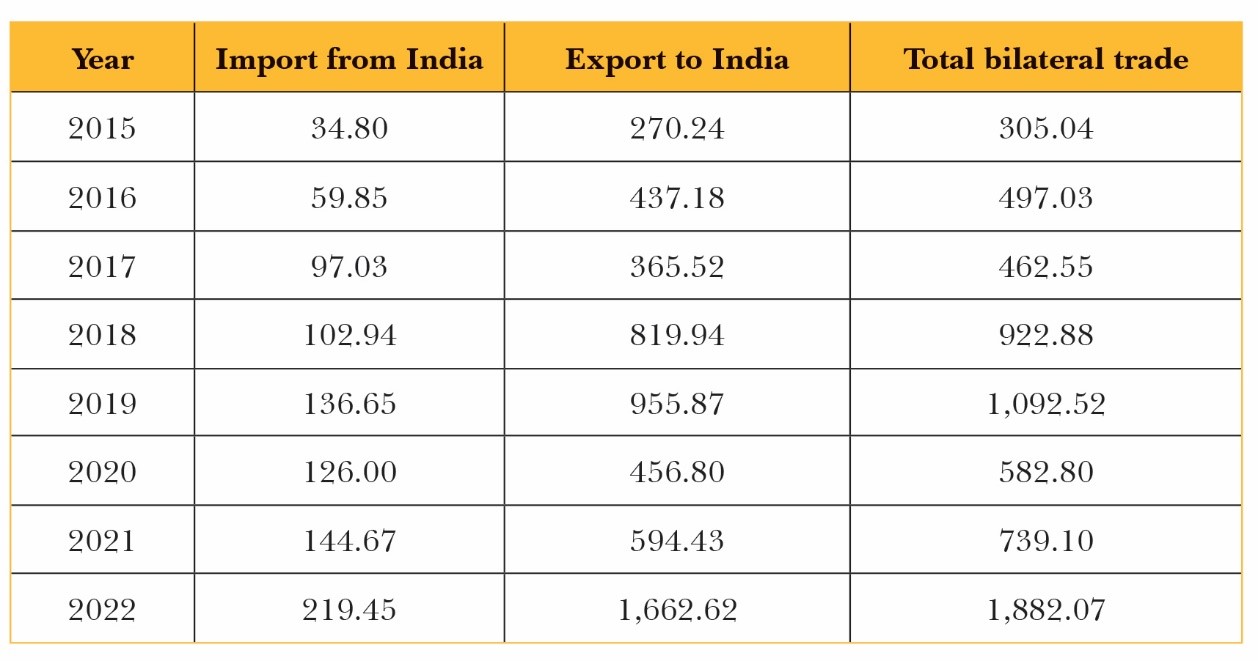
Source: State Statistical Committee of the Republic of Azerbaijan[46]
India is among Azerbaijan's top five trade partners.[47] India’s main exports to Azerbaijan are rice, electronics and electrical equipment, cereals, pharmaceuticals, machinery, boilers, nuclear reactors, ceramic products, agricultural and forestry tractors, vaccines, and black tea. At the same time, crude oil ore accounts for 98 percent of Azerbaijan’s export to India.[48] India can help Azerbaijan diversify its hydrocarbon dependence by partnering in the food processing, pharmaceutical, and technology sectors.
There is significant potential for further growth in trade between India and Azerbaijan through the INSTC’s Western Route, which provides a faster and more cost-effective transportation option for goods trade between the two countries. For instance, the completion of the Rasth-Astara railway line will reduce transit time along the INSTC’s Western Route to 10 days from the current 25-30 days.[49] India and Azerbaijan are keen to develop the transport corridor further[50] and even support the inclusion of the Chabahar Port in the INSTC.[51] Both countries are also exploring new areas for engagement, such as tourism. The commencement of direct flights between New Delhi and Baku by Indigo Airlines has seen an increase in the number of tourists travelling between the two countries. Notably, the people of Azerbaijan perceive India as a constructive power in the region.
India must strike a balance between short-term and long-term objectives in the region. Despite global economic turbulence, India remains the world's fastest-growing major economy, set to become a US$5 trillion economy and the world's growth engine.[52] For constant economic growth, India has stressed the development of reliable, resilient, and diversified supply chains that will require full connectivity and complete right to transit across Eurasia.[53] By 2030, India is poised to become a major global manufacturing centre, with the potential to export goods worth US$1 trillion.[54] Ensuring robust linkages between India and other regions, including Europe, is essential to promote sustained economic growth and prosperity for India and Eurasia.[55] If full connectivity is established, the India-Eurasia trade potential is about US$170 billion (US$60.6 billion in Indian exports to Eurasia and US$107.4 billion in India’s imports from Eurasia).[56]
India's participation in connectivity initiatives such as the INSTC is indicative of its aspirations to establish stable and affordable supply routes that can facilitate access to the European market. Since the Western Route of INSTC crosses the TITR in Azerbaijan, this will allow India to reach the European markets quickly. The imposition of stricter Western sanctions on Iran led to an investment crunch for India's infrastructure projects in the region despite receiving a waiver from the US. However, the US now concedes that increased connectivity between the CARs and South Asia is needed to diversify transport routes and networks.[57] Given China’s increased presence in the region, India must expedite the construction of the Chabahar-Zahedan railway line to counter the BRI. Additionally, India should offer tax breaks to Indian investors in INSTC projects to spur more interest, as private investors are currently reluctant.
India-Azerbaijan ties must also contend with political and geopolitical considerations, particularly related to the internal affairs of each country. While India has maintained a neutral stance on the Nagorno-Karabakh conflict,[f] Azerbaijan has backed Pakistan's stance on Kashmir.[58] Azerbaijan must exhibit sensitivity towards India’s internal affairs. At the same time, territorial disputes between Armenia and Azerbaijan are a significant obstacle to regional peace and stability in the Caspian region. India should use its substantial diplomatic capital to enable peace between Baku and Yerevan and make the region a driver of economic growth and reliable and resilient connectivity.
India, Azerbaijan, and the other countries along the INSTC and TITR routes must also address the critical issue of deviating and cumbersome tariff and customs rules and procedures, which currently contribute to significant transit delays. The countries along both routes should simplify tariffs and border control procedures using new technologies for the smooth movement of cargo. India, Azerbaijan, Georgia, Iran, and the CARs should consider establishing a government-level coordination group on this issue.
Conclusion
India and Azerbaijan share a history of cultural and economic ties, but there remain many untapped opportunities for cooperation between the two nations. Azerbaijan is India’s biggest trading partner in the Caucasus region, and New Delhi is one of the largest investors for Baku. India's growing economy and Azerbaijan's strategic location as a gateway to Europe and Asia offer the potential for increased trade and investment. India has emphasised the importance of creating reliable, resilient, and diversified supply chains, and Azerbaijan presents an opportunity to achieve this goal. As such, the INSTC’s Western Route and the TITR are significant for India.
Endnotes
[a] Russia, India, Iran, Türkiye, Azerbaijan, Belarus, Bulgaria, Armenia, Kazakhstan, Kyrgyz Republic, Oman, Tajikistan, and Ukraine.
[b] 25,000 TEUs
[c] Azerbaijan, Georgia, Kazakhstan, Turkey, Ukraine, Poland, Romania, Bulgaria, Lithuania, China, and Singapore.
[d] A single window system is a trade facilitation initiative that aims to simplify and streamline the import and export process by providing a single point of entry for all trade-related documentation and procedures. This means that traders only need to submit their information once to a single authority, instead of submitting it to multiple different government agencies. The World Trade Organization's Trade Facilitation Agreement (TFA), which came into force in 2017, includes provisions on single window systems and is now binding on all WTO members.
[e] Information provided by Port authorities in Baku during the visit.
[f] The Nagorno-Karabakh conflict is a long-standing and complex territorial dispute between Azerbaijan and Armenia over the Nagorna-Karabakh region. In 2020, a second war broke out between the two countries that lasted for six weeks and resulted in 6,000 deaths. Azerbaijan made significant territorial gains during the war, recapturing the seven surrounding districts and parts of Nagorno-Karabakh itself. Finally, in September 2023, Azerbaijan forces seized the whole of the disputed territory in a lightning offensive after defeating separatist ethnic Armenian fighters. Though the territory is internationally recognised as Azeri, more than 120,000 Armenians from Nagorna-Karabakh have fled to Armenia due to the recent offensive.
[1] Divya Kumar, “At this Azerbaijan fire temple, Sanskrit and Punjabi inscriptions find place,” The Hindu, November 04, 2018,
[2] Saadat Karimi, “The fire temple Ateshgah,” Saadat Karimi Blog, February 08, 2020,
[3] Ministry of External Affairs, Government of India, “Brief on India-Azerbaijan Bilateral Relations,” August 2022.
[4] Embassy Of India, Baku, Azerbaijan, “Brief on India-Azerbaijan Bilateral Relations,” https://www.indianembassybaku.gov.in/page/bilateral-brief/
[5] “Explained: INSTC, the transport route that has Russia and India’s backing,” Business Standard, July 14, 2022.
[6] Manoj Kumar and Nidhi Verma, “India likely to start full operations at Iran’s Chabahar port by May end”, Reuters, March 05, 2021, https://www.reuters.com/article/india-iran-ports-int-idUSKBN2AX1DK
[7] Orkhan Jalilov, “Iranian Railway Projects In Jeopardy Of Being Canned, Due To Trump’s Sanctions,” Caspian News, August 6, 2018.
[8] Suhasini Haidar, “Iran drops India from Chabahar rail project, cites funding delay,” The Hindu, July 14, 2020.
[9] Indrajit Roy, “Bringing Eurasia Closer,” The Hindu, August 01, 2022.
[10] “Online webinar highlights role of Azerbaijan in activating International North-South Transport Corridor,” The Azerbaijan State News Agency, June 24, 2021, https://azertag.az/en/xeber/Online_webinar_highlights_role_of_Azerbaijan_in_activating_International_North_South_Transport_Corridor-1815551
[11] Subhayan Chakraborty, “Need to build resilient supply chains, boost connectivity: PM Modi at SCO,” Business Standard, September 16, 2022, https://www.business-standard.com/article/economy-policy/need-to-build-resilient-supply-chains-boost-connectivity-pm-modi-at-sco-122091600820_1.html
[12] Central Asia Regional Economic Cooperation (CAREC) (2021), “Railway Sector Assessment for Azerbaijan,” https://www.carecprogram.org/uploads/2020-CAREC-Railway-Assessment_AZE_4th_2021-3-4_WEB.pdf
[13] Sara Israfilbayova, “Azerbaijan eyes to invest $1 billionin its railway infrastructure,” Deutsch-Aserbaidschanische Auslandshandelskammer, April 12, 2019, https://www.aserbaidschan.ahk.de/en/newsroom/news-details/azerbaijan-eyes-to-invest-1b-in-its-railway-infrastructure
[14] Aimee Hampel-Milagrosa, Aziz Haydarov, Kym Anderson, Jasmin Sibal, and Edimon Ginting, “Azebaijan Moving Toward More Diversified, Resilient, and Inclusive Development,” Asian Development Bank, August 2020, https://www.adb.org/sites/default/files/publication/624476/aze-diversified-resilient-inclusive-development.pdf
[15] “Explained: INSTC, the transport route that has Russia and India’s backing”
[16] Evgeny Vinokurov, Arman Ahunbaev, Marat Shashkenov, and Alexander Zaboev, “The International North–South Transport Corridor: Promoting Eurasia's Intra- and Transcontinental Connectivity, Reports and Working Papers, 21/5. Almaty, Moscow: Eurasian Development Bank, 2021, https://ssrn.com/abstract=4008994
[17] Vinokurov, Ahunbaev, Shashkenov, and Zaboev, “The International North–South Transport Corridor”
[18] Joshua Kucera, “Russia and Iran agree on new railroad corridor via Azerbaijan,” Eurasianet, May 26, 2023, https://eurasianet.org/russia-and-iran-agree-on-new-rail-corridor-via-azerbaijan
[19] “Baku set to become major Eurasian hub,” Freight Week, October 1, 2016, https://www.freightweek.org/index.php/en/viewpoints-2/2258-baku-set-to-become-major-eurasia-hub
[20] “ADB Approves $400 Million to Support Azerbaijan’s Rail Sector, Modernize North-South Railway Corridor,” Asian Development Bank, December 6, 2017, https://www.adb.org/news/adb-approves-400-million-support-azerbaijans-rail-sector-modernize-north-south-railway-corridor .
[21] “Azerbaijan Railway System: Well on Track with Austrian Expertise,” Asian Development Bank, October 26, 2022, https://www.adb.org/results/azerbaijan-railway-system-well-track-austrian-expertise
[22] Ilham Karimli, “Iran Expands Railroad Ties with Azerbaijan”, Caspian News, January 19, 2021, https://caspiannews.com/news-detail/iran-expands-railroad-ties-with-azerbaijan-2021-1-19-0/
[23] Farzad Ramezani Bonesh, “Iran’s Approach to the North and South Transport Corridors: Obstacle and Future Prospects,” Silk Road Briefing, June 19, 2023, https://www.silkroadbriefing.com/news/2023/06/19/irans-approach-to-the-north-and-south-transport-corridors-obstacles-future-prospects/#:~:text=The percent20INSTC percent20connects percent20India percent20to, percent2C percent20rail percent2C percent20and percent20sea percent20routes
[24] “Iran-Azerbaijan Rail Link A Modest Boost For International North-South Transport Corridor,” BMI, June 02, 2023, https://www.fitchsolutions.com/country-risk/iran-azerbaijan-rail-link-modest-boost-international-north-south-transport-corridor-02-06-2023?fSWebArticleValidation=true&mkt_tok=NzMyLUNLSC03NjcAAAGN1kotu3K5gPpeuK-V7DI89IgxbfHQIC3aIqq-KQqDYHngtyKi-vwerySqS6O8UgqtVT-lHtzhcrDuz4G6hvet8SxbmdQhQgNRhRcsICXoDovdzhDZ2A
[25] Kucera, “Russia and Iran agree on new railroad corridor via Azerbaijan”
[26] Ayjaz Wani, “The Middle Corridor and opportunities for India”, Observer Research Foundation, January 15, 2024, https://www.orfonline.org/research/the-middle-corridor-and-opportunities-for-india#:~:text=With%20a%20US%241.4%20billion,will%20be%20completed%20next%20year.
[27] “Russia: Rasht-Astara Railroad Completion to Take Four Years”, Financial Tribune, May 20, 2023, https://financialtribune.com/articles/domestic-economy/118174/russia-rasht-astara-railroad-completion-to-take-four-years
[28] Geeta Mohan, “Real reason why India sits out of Iran’s Chabahar-Zahedan rail link project,” India Today, July 21, 2020, https://www.indiatoday.in/india/story/iran-chabahar-zahedan-rail-link-project-india-1702928-2020-07-21
[29] Ayjaz Wani, “Slow, Not Steady: Assessing the Status of India-Eurasia Connectivity Projects”, Observer Research Foundation, February 2023, https://www.orfonline.org/wp-content/uploads/2023/02/ORF_IB-610_Status-of-India-Eurasia-connectivity-projects_ForUpload.pdf
[30] Nigar Jafarova, “The Rise of Middle Corridor,” Frontierview, May 25, 2023, https://frontierview.com/insights/the-rise-of-the-middle-corridor/
[31] Meray Ozat and Haley Nelson, “The Middle Corridor: The Beginning of the End for Russia’s Northern Corridor?,” Caspian Policy Center, June 30, 2023, https://www.caspianpolicy.org/research/energy-and-economy-program-eep/the-middle-corridor-the-beginning-of-the-end-for-russias-northern-corridor .
[32] Aimee Hampel-Milagrosa, Aziz Haydarov, Kym Anderson, Jasmin Sibal, and Edimon Ginting, “Azebaijan Moving Toward More Diversified, Resilient, and Inclusive Development,” Asian Development Bank, August 2020, https://www.adb.org/sites/default/files/publication/624476/aze-diversified-resilient-inclusive-development.pdf
[33] World Bank, “Middle Trade and Transport Corridor: Policies and Investments to Triple Freight Volumes and Halve Travel Time by 2030”, Washington, DC: World Bank, 2023, https://www.worldbank.org/en/region/eca/publication/middle-trade-and-transport-corridor
[34] Assel Satubaldina, “Cargo Transportation Along Middle Corridor Soars 88%, Reaches 2 Million Tons in 2023,” The Astana Times, December 28, 2023, https://astanatimes.com/2023/12/cargo-transportation-along-middle-corridor-soars-88-reaches-2-million-tons-in-2023/
[35] Navbahor Imamova, “Central Asian Trade Corridor Gains Interest Amid Regional Tensions”, Voice of America, December 29, 2023, https://www.voanews.com/a/central-asian-trade-corridor-gains-interest-amid-regional-tensions-/7390284.html
[36] Emil Avdaliani, “Will the Middle Corridor Evolve To Reshape Eurasian Connectivity Between China and the European Union,” Silk Road Briefing, March 02, 2023, https://www.silkroadbriefing.com/news/2023/03/02/will-the-middle-corridor-evolve-to-reshape-eurasian-connectivity-between-china-and-the-european-union/
[37] Jafarova, “The Rise of Middle Corridor”
[38] World Bank, “Middle Trade and Transport Corridor”
[39] World Bank, “Middle Trade and Transport Corridor”
[40] President of the Republic of Azerbaijan, Ilham Aliyev, “Shanghai Cooperation Organization member states summit gets underway in Samarkand,” September 16, 2022, https://president.az/en/articles/view/57224 .
[41] Vinokurov, “The International North–South Transport Corridor”
[42] James Jay Carafano, “Central Asia’s Middle Corridor gains traction at Russia’s expense” GIS, August 29, 2022, https://www.gisreportsonline.com/r/middle-corridor/
[43] The White House, “C5+1 Leaders’ Joint Statement”, Statements and Releases, September 21, 2023. https://www.whitehouse.gov/briefing-room/statements-releases/2023/09/21/c51-leaders-joint-statement/?_gl=1*1eihfd8*_gcl_au*MjAzNjU5OTU5Ni4xNzAyMTkyNzkx
[44] Emil Avdaliani, “China Still Ambivalent About the Middle Corridor”, Choice, January 26, 2023, https://chinaobservers.eu/china-still-ambivalent-about-the-middle-corridor/
[45] James Jay Carafano, “Central Asia’s Middle Corridor gains traction at Russia’s expense”, Geopolitical Intelligence Services AG, August 29, 2022, https://www.gisreportsonline.com/r/middle-corridor/
[46] Embassy Of India, Baku, Azerbaijan, “Economic and Commercial Brief,” https://www.indianembassybaku.gov.in/page/economic/
[47] “Ambassador: India is among 5 top trade partners of Azerbaijan,” Report News Agency, May 19, 2023, https://report.az/en/foreign-politics/ambassador-india-is-among-5-top-trade-partners-of-azerbaijan/ .
[48] Embassy Of India, “Economic and Commercial Brief”
[49] Nicola P. Contessi, “In the Shadow of the Belt and Road ” Center for Strategic and International Studies (CSIS), March 03, 2020, https://reconasia.csis.org/shadow-belt-and-road/
[50] “Indian Ambassador: Azerbaijan is an important partner in North-South Transport Corridor-INTERVIEW,” Report News Agency, July 16, 2021, https://report.az/en/foreign-politics/ambassador-india-and-azerbaijan-share-long-historical-and-deep-cultural-ties/ .
[51] “Hopeful membership of INSTC project will be expanded: Jaishankar,” The Economics Times, March 04, 2021, https://economictimes.indiatimes.com/news/politics-and-nation/hopeful-membership-of-instc-project-will-be-expanded-jaishankar/articleshow/81329027.cms?from=mdr .
[52] “India on course to become USD 5 trillion economy by FY26: CEA”, The Economic Times, February 01, 2022,
https://economictimes.indiatimes.com/news/economy/finance/india-on-course-to-become-usd-5-trillion-economy-by-fy26-cea/articleshow/89281393.cms?from=mdr
[53] “PM Modi attends 22nd SCO Summit at Samarkand; Says, SCO needs to focus on bringing diversified, resilient supply chains,” News Service Division, All India Radio, September 16, 2022, https://newsonair.gov.in/News?title=PM-Modi-attends-22nd-SCO-Summit-at-Samarkand percent3B-Says percent2C-SCO-needs-to-focus-on-bringing-diversified percent2C-resilient-supply-chains&id=447767 .
[54] Pritam Deuskar, “India – A 1 trillion manufacturing export market by 2030”, Mint, December 1, 2022, https://www.livemint.com/economy/india-a-1-trillion-manufacturing-export-market-by-2030-11669800286004.html
[55] “Goods and services exports may reach $1 trillion each by 2030: Piyush Goyal”, Business Standard, February 21, 2023, https://www.business-standard.com/article/economy-policy/goods-and-services-exports-may-reach-1-trillion-each-by-2030-piyush-goyal-123022101072_1.html
[56] P. Stobdan and Ashok Behuria, G. Balachandran, Chabahar: Gateway to Eurasia, (Ladakh International Centre, 2017)
[57] The White House, “C5+1 Leaders’ Joint Statement”
[58] Aditi Bhaduri, “India must ignore Azerbaijan’s gripe over arms supplies to Armenia”, Money Control, August 11, 2023, https://www.moneycontrol.com/news/opinion/india-must-ignore-azerbaijans-gripe-over-arms-supplies-to-armenia-11153341.html
The views expressed above belong to the author(s). ORF research and analyses now available on Telegram! Click here to access our curated content — blogs, longforms and interviews.

 PDF Download
PDF Download

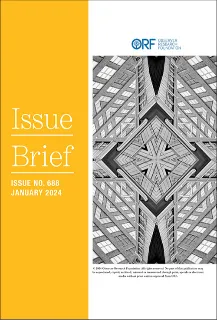






 PREV
PREV
